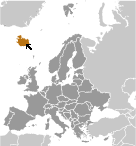World Atlas: Iceland. On this page you can see the map, country flag and many detailed information about the people, history and economy of Iceland.

Here you can find online selected information about the geography, inhabitants, government, economy and history of Iceland. Included are selected statistics, an overview map and the detailed map of Iceland. But let's start with the flag of Iceland here:
Iceland - Overview:
What you should know about Iceland? Let's start with this: Settled by Norwegian and Celtic (Scottish and Irish) immigrants during the late 9th and 10th centuries A.D., Iceland boasts the world's oldest functioning legislative assembly, the Althingi, established in 930. Independent for over 300 years, Iceland was subsequently ruled by Norway and Denmark. Fallout from the Askja volcano of 1875 devastated the Icelandic economy and caused widespread famine. Over the next quarter century, 20% of the island's population emigrated, mostly to Canada and the US. Denmark granted limited home rule in 1874 and complete independence in 1944. The second half of the 20th century saw substantial economic growth driven primarily by the fishing industry. The economy diversified greatly after the country joined the European Economic Area in 1994, but Iceland was especially hard hit by the global financial crisis in the years following 2008. The economy is now on an upward trajectory, fueled primarily by a tourism and construction boom. Literacy, longevity, and social cohesion are first rate by world standards.
Geography of Iceland
 Where on the globe is Iceland? The location of this country is Northern Europe, island between the Greenland Sea and the North Atlantic Ocean, northwest of the United Kingdom. Total area of Iceland is 103,000 sq km, of which 100,250 sq km is land. So this is not a large country. How could we describe the terrain of the country? This way: mostly plateau interspersed with mountain peaks, icefields; coast deeply indented by bays and fiords. The lowest point of Iceland is Atlantic Ocean 0 m, the highest point Hvannadalshnukur 2,110 m (at Vatnajokull Glacier). And the climate is temperate; moderated by North Atlantic Current; mild, windy winters; damp, cool summers.
Where on the globe is Iceland? The location of this country is Northern Europe, island between the Greenland Sea and the North Atlantic Ocean, northwest of the United Kingdom. Total area of Iceland is 103,000 sq km, of which 100,250 sq km is land. So this is not a large country. How could we describe the terrain of the country? This way: mostly plateau interspersed with mountain peaks, icefields; coast deeply indented by bays and fiords. The lowest point of Iceland is Atlantic Ocean 0 m, the highest point Hvannadalshnukur 2,110 m (at Vatnajokull Glacier). And the climate is temperate; moderated by North Atlantic Current; mild, windy winters; damp, cool summers.
Inhabitants of Iceland
Let's take a look how many people live in Iceland. The number is: 339,747 (July 2017 est.). So not so many people live here. Who lives here? homogeneous mixture of descendants of Norse and Celts 94%, population of foreign origin 6%. What are the languages in Iceland? Icelandic, English, Nordic languages, German widely spoken. And the religions: Evangelical Lutheran Church of Iceland (official) 69.9%, Roman Catholic 3.8%, Reykjavik Free Church 2.9%, Hafnarfjorour Free Church 2%, Asatru Association 1.1%, The Independent Congregation 1%, other religions 4% (includes Zuist and Pentecostal), none 6.1%, other or unspecified 9.2% (2017 est.). How old are the people in average? 36.5 years. We have to add that this number is the median - so one half of the people is older than this, one half is younger. And what is their life expectancy (at birth)? This: 83.1 years. Where the people live in Iceland? Here: Iceland is almost entirely urban with half of the population located in and around the capital of Reykjavik; smaller clusters are primarily found along the coast in the north and west. The major urban areas of Iceland are: Reykjavik (capital) 184,000 (2014).
Government and Economy of Iceland
The capital of Iceland is Reykjavik and the government type parliamentary republic. Let's take a look at the administrative divisions - 8 regions; Austurland, Hofudhborgarsvaedhi, Nordhurland Eystra, Nordhurland Vestra, Sudhurland, Sudhurnes, Vestfirdhir, Vesturland. Regarding the economy of Iceland, important industrial products are tourism, fish processing; aluminum smelting;; geothermal power, hydropower; medical/pharmaceutical products. Important agricultural products are potatoes, carrots, green vegetables, tomatoes, cucumbers; mutton, chicken, pork, beef, dairy products; fish. The most important export commodities are fish and fish products (42%), aluminum (38%), agricultural products, medicinal and medical products, ferro-silicon (2015) and the most important export partners are Netherlands 25.4%, UK 11.3%, Spain 10.5%, US 7.8%, Germany 7%, France 6.7%, Norway 4.2% (2016). The most important import commodities are machinery and equipment, petroleum products, foodstuffs, textiles and the most important import partners are Germany 10.1%, US 10%, Norway 9.1%, Netherlands 7.5%, China 7.4%, Denmark 6.1%, UK 5.8% (2016). How rich is Iceland and how rich are people in this country? The most important number here is GDP per capita (PPP): $52,100 (2017 est.). This means the people are rich on average here. Let's add that this means Gross Domestic Product per person, which is recalculated with respect to the relative cost of local goods and services. And one more important number - population below poverty line: NA%.